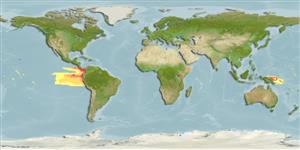Classification / Names
Nombres comunes | Sinónimos | Catalog of Fishes(Género, Especie) | ITIS | CoL | WoRMS | Cloffa
>
Lophiiformes (Anglerfishes) >
Oneirodidae (Dreamers)
Etymology: Chaenophryne: Greek, 'chaeno' or 'chaino' = to gape + Greek, 'phryne' = toad (alluring to a "gaping toad") (Ref. 86949).
More on authors: Regan & Trewavas.
Environment: milieu / climate zone / depth range / distribution range
Ecología
marino batipelágico; rango de profundidad ? - 1250 m (Ref. 58018), usually 300 - 1000 m (Ref. 86949). Deep-water; 9°N - 13°S, 140°E - 78°W
Western Central Pacific: Papua New Guinea. Eastern Central Pacific: Gulf of Panama.
Tamaño / Peso / Age
Maturity: Lm ? range ? - ? cm
Max length : 10.2 cm SL macho / no sexado; (Ref. 75756)
Short description
Claves de identificación | Morfología | Morfometría
Radios blandos dorsales (total) : 6 - 8; Radios blandos anales: 5 - 6. Distinguishing characteristics of metamorphosed female: esca with single elongate internally pigmented anterior appendage, less than one-fourth to nearly one-third length of escal bulb; absence of medial escal appendages; posterior escal appendages with swollen basal portion and compressed distal crest, posterior filament or filaments and pair of anterior lobes each with numerous filaments; filamentous anterolateral escal appendage on each side; absence of basal series of filaments; total number of teeth in upper jaw 21-45, lower jaw with 26-42 teeth; ratio between number of teeth in upper jaw to lower jaw teeth 0.78-1.30; vomerine teeth 4-7; length of illicium 20.1-41.3% SL; escal bulb width 2.1-6.3% SL (Ref. 86949).
Life cycle and mating behavior
Madurez | Reproducción | Puesta | Huevos | Fecundidad | Larva
Kailola, P.J., 1987. The fishes of Papua New Guinea. A revised and annotated checklist. Vol. 1. Myxinidae to Synbranchidae. Research Bulletin No. 41. Department of Fisheries and Marine Resources, Port Moresby, Papua New Guinea. 194 p. (Ref. 6993)
IUCN Red List Status (Ref. 130435: Version 2024-1)
Threat to humans
Harmless
Human uses
Herramientas
Special reports
Download XML
Fuentes de Internet
Estimates based on models
Preferred temperature (Ref.
123201): 4.8 - 8.3, mean 6 °C (based on 23 cells).
Phylogenetic diversity index (Ref.
82804): PD
50 = 0.5312 [Uniqueness, from 0.5 = low to 2.0 = high].
Bayesian length-weight: a=0.01995 (0.00906 - 0.04395), b=3.01 (2.83 - 3.19), in cm total length, based on all LWR estimates for this body shape (Ref.
93245).
Nivel trófico (Ref.
69278): 3.7 ±0.5 se; based on size and trophs of closest relatives
Resiliencia (Ref.
120179): Alto, población duplicada en un tiempo mínimo inferior a 15 meses (Preliminary K or Fecundity.).
Fishing Vulnerability (Ref.
59153): Low vulnerability (10 of 100).
